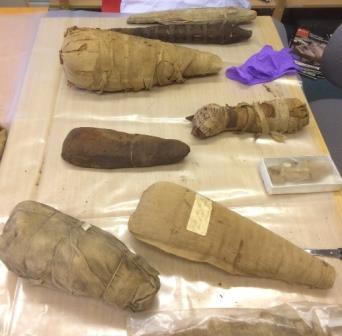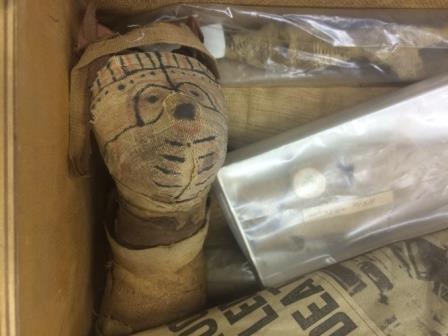Ten missing animal mummies come home!

Just before Christmas ten animal mummies were returned to World Museum after 40 years. The excitement all started in late October when I got an interesting message about a box of crocodiles and a cat from Hannah who works on the information desk at World Museum (it was like Christmas come early AND it was actually my birthday that day). The daughter of an academic had contacted the museum to explain that her father had been part of a research project working with the museum in the 1960s. He'd recently passed away and she was eager to return a box of objects that he had. In the late 1960s the museum worked with a group of medics to study our collection of mummified human remains. The results of a radiographic examination were published as a catalogue in 1968, which at the time lead the way for other museums to follow.
 A mummified cat peering out of the opened box
At the same time one researcher was studying the underlying bone structure of some mummified animals which had been sent to his laboratory. The study was never published and the loan of objects was never recalled. Museum staff changed and the animal mummies were forgotten about. Indeed by the 1990s when they could not be found during an audit of the collection the record cards were marked with stickers to indicate they were lost during the chaos of the Second World War when the museum was destroyed by an incendiary bomb. Nowadays museums follow a much stricter policy when it comes to lending out collections but when you’re curating a collection over 150 years old you inherit documentation problems like this. When the box arrived in my office I was thrilled to find ten animal mummies! I photographed them all to record their condition and then sent them to our senior organics conservator for a condition assessment (which included a deep freeze to remove any pests!). I'll write an update on the animal mummies after we have done some more conservation work with them, but here is a brief description with links to our expanding online database.
A mummified cat peering out of the opened box
At the same time one researcher was studying the underlying bone structure of some mummified animals which had been sent to his laboratory. The study was never published and the loan of objects was never recalled. Museum staff changed and the animal mummies were forgotten about. Indeed by the 1990s when they could not be found during an audit of the collection the record cards were marked with stickers to indicate they were lost during the chaos of the Second World War when the museum was destroyed by an incendiary bomb. Nowadays museums follow a much stricter policy when it comes to lending out collections but when you’re curating a collection over 150 years old you inherit documentation problems like this. When the box arrived in my office I was thrilled to find ten animal mummies! I photographed them all to record their condition and then sent them to our senior organics conservator for a condition assessment (which included a deep freeze to remove any pests!). I'll write an update on the animal mummies after we have done some more conservation work with them, but here is a brief description with links to our expanding online database.
 The contents of the box laid out on a desk
There are four mummified ibises (well until we can x-ray them that is what we think!) three of which are from the founding collection of Joseph Mayer (nos. M11101, M11106 and M13647a) and one collected by Herman Philip and his wife Dora Philip who visited the once lost but now found again ‘Ibis Tomb’ at Saqqara in the 1850s (no. 16.4.61.16). There are not one but three crocodiles! (I love crocodile mummies). One is very tiny (no. 56.21.514) but the other two are larger, or at least much better wrapped (again we won’t know until we x-ray each). One crocodile is said to have been collected from the Italian explorer Giovanni Belzoni in 1834 (no. 56.21.545) and the other crocodile was found during the excavations of the University of Liverpool at Esna in 1906 (no. 16.11.06.153). The smallest and most fragile mummy is that of a fish only 15 cm in length (no. 56.21.480). To end with is my favourite (unlike parents I think curators are allowed favourites) a mummified cat with a painted face (no. 15.2.07.2a). It was given by bequest in 1907 by Miss Margaret Eleanor Moss of Bebbington, Wirral. We know nothing about Miss Moss - other than she kept the cat in a glass case alongside a mummified human head – so if you can help pad out this object biography please do contact us!
The contents of the box laid out on a desk
There are four mummified ibises (well until we can x-ray them that is what we think!) three of which are from the founding collection of Joseph Mayer (nos. M11101, M11106 and M13647a) and one collected by Herman Philip and his wife Dora Philip who visited the once lost but now found again ‘Ibis Tomb’ at Saqqara in the 1850s (no. 16.4.61.16). There are not one but three crocodiles! (I love crocodile mummies). One is very tiny (no. 56.21.514) but the other two are larger, or at least much better wrapped (again we won’t know until we x-ray each). One crocodile is said to have been collected from the Italian explorer Giovanni Belzoni in 1834 (no. 56.21.545) and the other crocodile was found during the excavations of the University of Liverpool at Esna in 1906 (no. 16.11.06.153). The smallest and most fragile mummy is that of a fish only 15 cm in length (no. 56.21.480). To end with is my favourite (unlike parents I think curators are allowed favourites) a mummified cat with a painted face (no. 15.2.07.2a). It was given by bequest in 1907 by Miss Margaret Eleanor Moss of Bebbington, Wirral. We know nothing about Miss Moss - other than she kept the cat in a glass case alongside a mummified human head – so if you can help pad out this object biography please do contact us!
